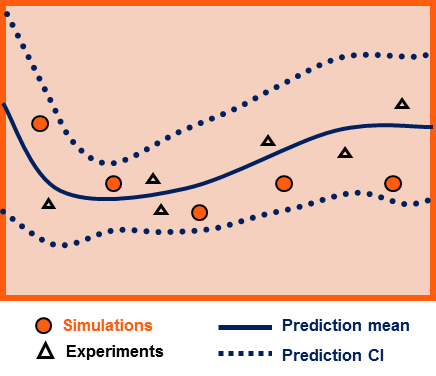|
Uncertainty Quantification
Uncertainty quantification (UQ) is the science of quantitative characterization and reduction of uncertainties in both computational and real world applications. It tries to determine how likely certain outcomes are if some aspects of the system are not exactly known. An example would be to predict the acceleration of a human body in a head-on crash with another car: even if the speed was exactly known, small differences in the manufacturing of individual cars, how tightly every bolt has been tightened, etc., will lead to different results that can only be predicted in a statistical sense. Many problems in the natural sciences and engineering are also rife with sources of uncertainty. Computer experiments on computer simulations are the most common approach to study problems in uncertainty quantification. Sources Uncertainty can enter mathematical models and experimental measurements in various contexts. One way to categorize the sources of uncertainty is to consider: ; Paramet ... [...More Info...] [...Related Items...] OR: [Wikipedia] [Google] [Baidu] |
Uncertainty
Uncertainty refers to epistemic situations involving imperfect or unknown information. It applies to predictions of future events, to physical measurements that are already made, or to the unknown. Uncertainty arises in partially observable or stochastic environments, as well as due to ignorance, indolence, or both. It arises in any number of fields, including insurance, philosophy, physics, statistics, economics, finance, medicine, psychology, sociology, engineering, metrology, meteorology, ecology and information science. Concepts Although the terms are used in various ways among the general public, many specialists in decision theory, statistics and other quantitative fields have defined uncertainty, risk, and their measurement as: Uncertainty The lack of certainty, a state of limited knowledge where it is impossible to exactly describe the existing state, a future outcome, or more than one possible outcome. ;Measurement of uncertainty: A set of possible states or outc ... [...More Info...] [...Related Items...] OR: [Wikipedia] [Google] [Baidu] |
Moment (mathematics)
In mathematics, the moments of a function are certain quantitative measures related to the shape of the function's graph. If the function represents mass density, then the zeroth moment is the total mass, the first moment (normalized by total mass) is the center of mass, and the second moment is the moment of inertia. If the function is a probability distribution, then the first moment is the expected value, the second central moment is the variance, the third standardized moment is the skewness, and the fourth standardized moment is the kurtosis. The mathematical concept is closely related to the concept of moment in physics. For a distribution of mass or probability on a bounded interval, the collection of all the moments (of all orders, from to ) uniquely determines the distribution (Hausdorff moment problem). The same is not true on unbounded intervals (Hamburger moment problem). In the mid-nineteenth century, Pafnuty Chebyshev became the first person to think systematic ... [...More Info...] [...Related Items...] OR: [Wikipedia] [Google] [Baidu] |
Importance Sampling
Importance sampling is a Monte Carlo method for evaluating properties of a particular distribution, while only having samples generated from a different distribution than the distribution of interest. Its introduction in statistics is generally attributed to a paper by Teun Kloek and Herman K. van Dijk in 1978, but its precursors can be found in statistical physics as early as 1949. Importance sampling is also related to umbrella sampling in computational physics. Depending on the application, the term may refer to the process of sampling from this alternative distribution, the process of inference, or both. Basic theory Let X\colon \Omega\to \mathbb be a random variable in some probability space (\Omega,\mathcal,P). We wish to estimate the expected value of ''X'' under ''P'', denoted E 'X;P'' If we have statistically independent random samples x_1, \ldots, x_n, generated according to ''P'', then an empirical estimate of E 'X;P''is : \widehat_ ;P= \frac \sum_^n x_i \quad \m ... [...More Info...] [...Related Items...] OR: [Wikipedia] [Google] [Baidu] |
Bias Correction
Bias is a disproportionate weight ''in favor of'' or ''against'' an idea or thing, usually in a way that is closed-minded, prejudicial, or unfair. Biases can be innate or learned. People may develop biases for or against an individual, a group, or a belief. In science and engineering, a bias is a systematic error. Statistical bias results from an unfair sampling of a population, or from an estimation process that does not give accurate results on average. Etymology The word appears to derive from Old Provençal into Old French ''biais'', "sideways, askance, against the grain". Whence comes French ''biais'', "a slant, a slope, an oblique". It seems to have entered English via the game of bowls, where it referred to balls made with a greater weight on one side. Which expanded to the figurative use, "a one-sided tendency of the mind", and, at first especially in law, "undue propensity or prejudice". Types of bias Cognitive biases A cognitive bias is a repeating or basic miss ... [...More Info...] [...Related Items...] OR: [Wikipedia] [Google] [Baidu] |


